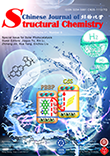
Ruiqi Gao, Huan He, Junxian Bai, Lei
Hao,
Rongchen Shen*, Peng Zhang, Youji Li and Xin Li*
The blue cover, together with elements such as blisters, lightning and the sun, highlights the good prospect of this new type of heterojunction as a photocatalytic material. The "S" shaped dragon depicted by the element of water rises from the bottom, implying that the dragon gets water and magically turns water into green hydrogen over organic/inorganic S-type heterojunction photocatalyst under sunlight irradiation.
S-scheme Porous g-C3N4/Ag2MoO4 Heterojunction Composite for CO2 Photoreduction
Zhongliao Wang, Ruilian Liu, Jinfeng Zhang* and Kai Dai*
Chin. J. Struct. Chem. 2022, 41, 2206015-2206022 DOI: 10.14102/j.cnki.0254-5861.2022-0108
June 20, 2022
S-scheme, g-C3N4, Ag2MoO4, heterojunction, CO2 photoreduction
ABSTRACT
Utilizing
solar energy to achieve artificial photosynthesis of chemical fuel is prevalent in tackling excessive CO2 emission and
fossil fuel depletion. Grievous charge recombination
and weak redox capability aggravate the CO2 photoreduction
performance. Engineering tailored morphology and constructing matched heterostructure are two significant schemes to
ameliorate the CO2 photoconversion efficiency of g-C3N4-based composite. Herein,
a novel S-scheme ultrathin
porous g-C3N4 (UPCN)/Ag2MoO4 (AMO)
composite was designed by in-situ growing tetragonal α-AMO nanoparticles (NPs) (5-30 nm) on UPCN nanosheets
(NSs). The S-scheme charge transfer route endows UPCN/AMO with fast charge
separation and strong redox capability, demonstrated by X-ray photoelectron
spectroscopy (XPS), photoelectrochemical tests, steady-state and time-resolved
photoluminescence (PL) spectra, and DFT calculations. The
UPCN/AMO composite exhibits elevated CO2 photoreduction performance
with CO and CH4 yield rates of 6.98 and 0.38 μmol g-1 h-1,
which are 3.5 and 2.9 folds higher than that of pristine UPCN, respectively. Finally,
the CO2 photoreduction intermediates are analyzed, and the CO2 photoreduction mechanism is discussed. This work provides a reference for various
g-C3N4-based composites applied in artificial
photosynthesis.







